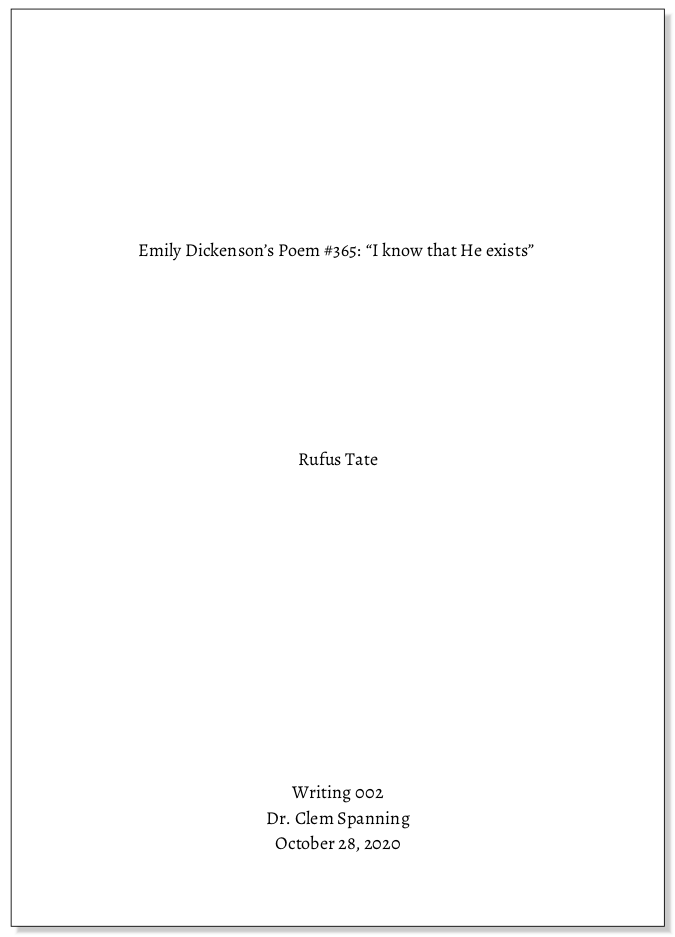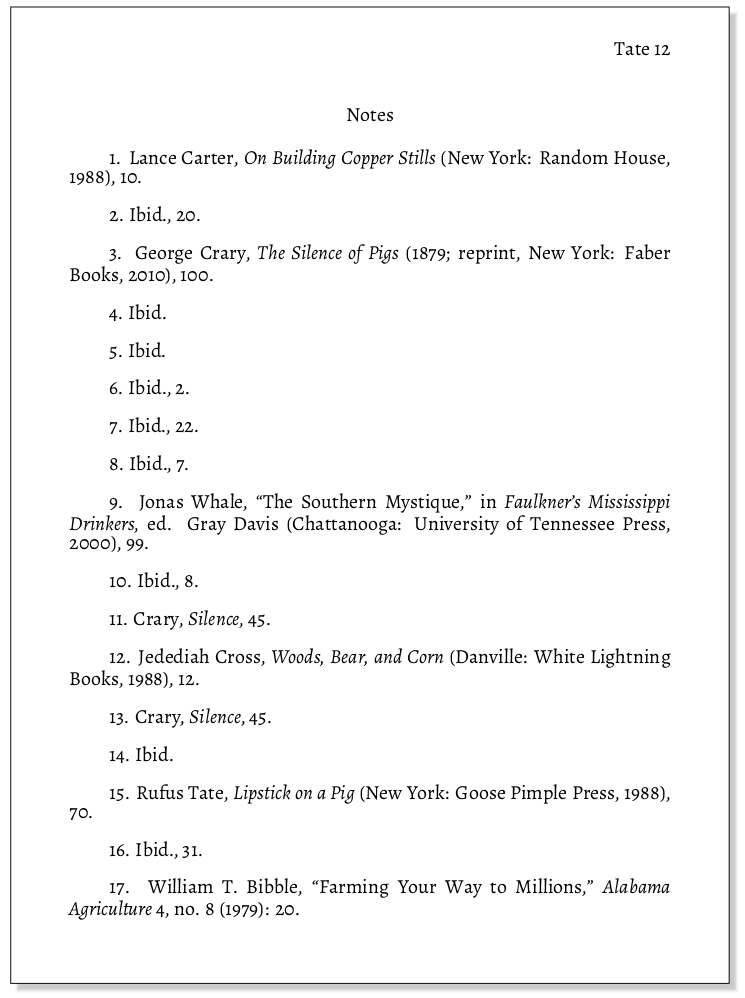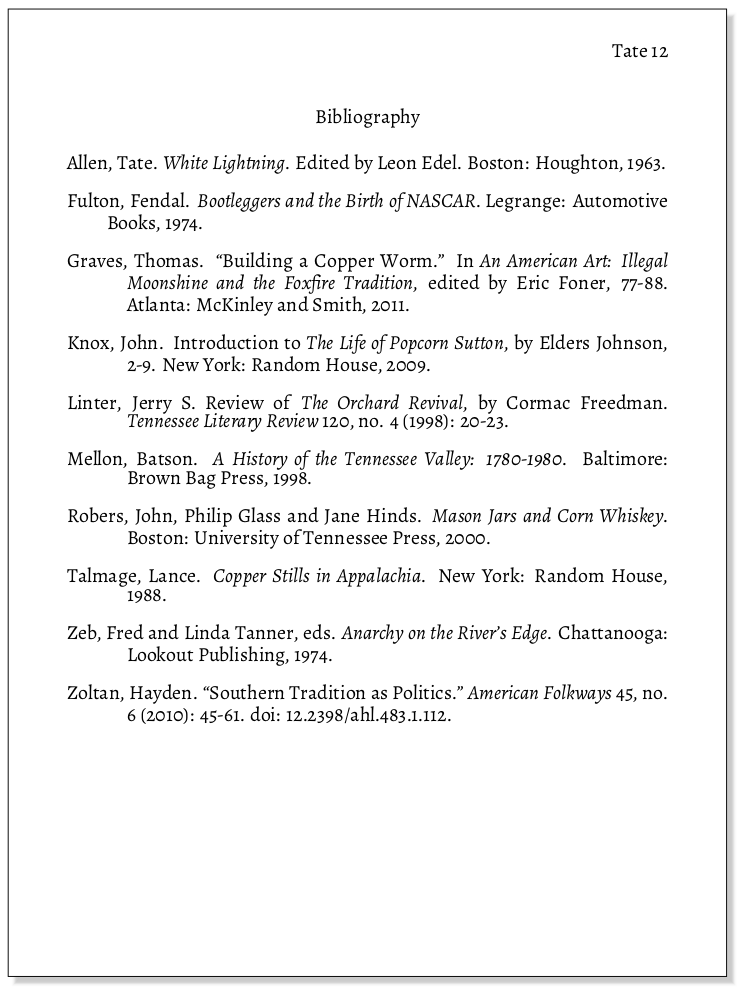Open Handbook
Chicago Style
Our library has access to an online copy of the newest Chicago Style Manual.
Chicago document formatting
When setting up your word processor for an Chicago-formatted document, use the following settings to format your page:
Chicago Page Formatting
-
Use one-inch margins on all sides of the document.
-
Place the page number on the right side of each page in the document’s header. If instructed to do so by a professor, include your last name before the page number on each page.
-
Double space the document.
-
Block quotes are formed when a quote runs more than 100 words. Indent the entire block of text with a 1/2-inch tab from the left margin.
-
Endnotes and bibliographic entries are single-spaced with a blank line separating them.
-
Indent the first line of a note entry with a 1/2-inch tab.
-
Indent the second, and any subsequent, line of a bibliographic entry with a 1/2-inch tab.
-
The Chicago form requires a title page. The title of the essay is centered about 1/3 down the top of the page. Place your name, course information, and date on three separate, centered lines at the center of the document.
-
The title page is counted but not numbered. This means that the first page of your essay proper will be numbered 2 and your title page will have no page number on it.
Example:


Chicago Notes page formatting
The Chicago style has two ways of approaching citation. In one method, known as author-date, references are placed in the text within a parenthesis using the author’s last name and the year of the source’s publication. The author-date method is common in the sciences and social sciences. A second method is known as notes and bibliography. In this method, in-text citations are made using either footnotes, which appear at the bottom of a page, or endnotes, which appear on a separate Notes page at the conclusion of the document. This handbook only presents the notes and bibliography method with endnotes.
To set up your Notes page properly, follow the rules below:
Formatting the Notes page
Setting up the Notes page
When setting up the Notes page, use the following rules:
-
Center the word “Notes” at the top of the page.
-
Place the page number on the right side of each page in the document’s header. If instructed to do so by a professor, include your last name before the page number on each page.
-
Single-space the endnotes with a line separating entries.
-
Indent the first line of an endnote entry with a 1/2-inch tab.
Making endnote or footnote entries
When making footnote or endnote entries, the Chicago form prescribes a specific strategy designed to lessen the work involved. While this design ultimately means less typing, a number of strict rules must be followed:
-
Present the citations in the numerical order as they appear within the text.
-
The first time a source is cited, use the full Chicago notes form.
-
If the same source is used more than once, the shorthand version of the Chicago notes form is used the second (and each subsequent) time. The shorthand version contains a) the author’s last name, b) a shortened version of the title, and c) the page number(s) of the citation.
-
If a source is used twice (or more) in a row, the Latin abbreviation “Ibid.” is used along with the page number, rather than the shorthand version of the form. (Ibid. means “in the same place.”)
-
If a source is used twice (or more) in a row and the citation is from the same page, “Ibid.” is used by itself without the page number.
Example:

Chicago Bibliography page formatting
The Chicago style does not require that you include a bibliography page at the conclusion of your essay; the Notes page is often sufficient unless the work is very long or contains a large number of citations. However, your professor may require one. To construct a Chicago bibliography, follow the rules below:
Formatting the Bibliography page
Setting up the Bibliography page
To format a Chicago bibliography page, use the following rules:
-
Place the bibliography page after the notes page.
-
Place the page number on the right side of each page in the document’s header. If instructed to do so by a professor, include your last name before the page number on each page.
-
Center the word “Bibliography” at the top of the page.
-
Single-space entries with a line separating entries.
-
Alphabetize by the author’s last name.
-
Indent the second (and any subsequent) line of an entry with a 1/2-inch tab.
Example:

Chicago in-text citations
When using Chicago’s notes and bibliography method of citation, in-text citations are made using either footnotes, which appear at the bottom of a page, or endnotes, which appear on a separate “Notes” page at the conclusion of the document. This handbook exclusively presents the notes and bibliography method using endnotes.
Chicago in-text citations
In-text citations
In the Chicago form, an in-text citation is indicated by a superscript number resembling the following:
Recent scholarship on the concept of sovereignty has displayed a remarkable lack of interest in Native peoples.7
This in-text reference will correspond to either a footnote at the bottom of the page or an endnote on the Notes page at the conclusion of the document. The reference will resemble the one below:
7. Giorgio Agamben, Homo Sacer: Sovereign Power and Bare Life (Stanford: Stanford University Press, 1998), 96.
Citing your sources in Chicago
The following section provides examples for citing sources that are commonly found in academic writing. Both the Notes and Bibliography forms are included. The various forms have been organized into sections on books, periodicals, electronic sources, and other types of sources that are less common.
🔴️ Click on “Bibliography” or “Notes” to reveal the proper form:
Citing Books
Book Forms
A book by one author:
Taylor, Herman. A Tale of the City: Living and Dying in New York’s Slums. New York: Little and Sons, 1998.
1. Herman Taylor, A Tale of the City: Living and Dying in New York’s Slums (New York: Little and Sons, 1998), 77.
Multiple authors:
Roberts, John, Philip Glass and Jane Hinds. Recovering the City of Boston. Boston: University of Massachusetts Press, 2000.
1. John Roberts, Philip Glass, and Jane Hinds, Recovering the City of Boston (Boston: University of Massachusetts Press, 2000), 77.
A book with an editor:
James, Henry. Portrait of a Lady. Edited by Leon Edel. Boston: Houghton, 1963.
12. Henry James, Portrait of a Lady, ed. Leon Edel (Boston: Houghton, 1963), 77.
Book with editor only:
Smith, Edward, ed. Stuck in Goshen. Nashville: Greenwood Press, 1963.
Zebe, Fred and Linda Tanner, eds. Anarchy on the River’s Edge. Chattanooga: Lookout Publishing, 1974.
17. Edward Smith, ed., Stuck in Goshen (Nashville: Greenwood Press, 1963), 77.
18. Fred Zebe and Linda Tanner, eds., Anarchy on the River’s Edge. (Chattanooga: Lookout Publishing, 1974), 77.
- If there are multiple editors, use “eds.”
An edition (other than the first):
Thompson, Fred. Why I Fight. 3rd ed. New York: Vanity Publications, 2000.
12. Fred Thompson, Why I Fight, 3rd. ed. (New York: Vanity Publications, 2000), 77.
Corporate author (written by organization or government):
John Bigan Society. The Religions of Kenya. New York: John Bigan Publishing, 2000.
10. John Bigan Society, The Religions of Kenya (New York: John Bigan Publishing, 2000), 77.
An anthology:
Foner, Eric, ed. An American Voice: A Collection of America’s Finest Essays. Boston: McKinley and Smith, 2011.
15. Eric Foner, ed., An American Voice: A Collection of America’s Finest Essays (Boston: McKinley and Smith, 2011), 77.
A work in an anthology:
Graves, Thomas. “The History of our National Anthem.” In An American Voice: A Collection of America’s Finest Essays, edited by Eric Foner, 77-88. Boston: McKinley and Smith, 2011.
13. Thomas Graves, “The History of our National Anthem,” in An American Voice: A Collection of America’s Finest Essays, ed. Eric Foner (Boston: McKinley and Smith, 2011), 77-88.
No author or editor:
A Wicked Guide to Boston. Boston: Beantown Publishing, 2000.
25. A Wicked Guide to Boston (Boston: Beantown Publishing, 2000), 22.
Introduction, preface, forward or afterward:
Knox, John. Introduction to The Life of James, by Elders Johnson, 2-9. New York: Random House, 2009.
33. John Knox, introduction to The Life of James, by Elders Johnson (New York: Random House, 2009), 7.
- Substitute the word introduction with preface, afterward, or foreword as needed.
Book with a translator:
McDougle, Astrid. The Basics of Gaelic. Translated by Paddy Maloney. New York: Vintage, 1990.
45. Astrid McDougle, The Basics of Gaelic, trans. Paddy Maloney (New York: Vintage, 1990), 22.
Multivolume work:
Graves, Johanna. Ronald Reagan and the Iran-Contra Affair. Vol. 7. New York: Greenstalk, 1988.
23. Johanna Graves, Ronald Reagan and the Iran-Contra Affair, vol. 7 (New York: Greenstalk, 1988), 77.
- If the volume has a separate title, place a comma after the volume number and enter its name in italics.
Book in a series:
Smith, Rod. American Economic Expansion in the Gilded Age. American Economic History Series. New York: Grim and Drang, 1988.
44. Rod Smith, American Economic Expansion in the Gilded Age, American Economic History Series (New York: Grim and Drang, 1988), 78.
Republished Book:
Cranston, Brian. Outlooks on Faith and Reason. 1979. Reprint, New York: Stroke and Crowder, 2000.
44. Brian Cranston, Outlooks on Faith and Reason (1979; reprint, New York: Stroke and Crowder, 2000), 9.
Article in a reference work, such as a dictionary or encyclopedia:
22. Merriam-Webster’s Collegiate Dictionary, 10th ed., s.v. “Suzerian.”
- Well-known reference sources, such as encyclopedias or dictionaries, that are arranged alphabetically by word or term do not require page numbers or need to be included in your bibliography. Abbreviate the Latin term sub verbo, or “under the word,” in your note to indicate this.
Sacred texts
22. Genesis 2: 2-5 (New International Version).
- For sacred texts such as the Bible, Koran, or Torah, cite the work in your notes, but not the bibliography. In the note, provide information about the chapter and verse, but not the page number. If there is a version, put that information in parenthesis after the chapter and verse information.
Book with title within the title:
Hixson, Fred. On Cormac McCarthy’s Blood Meridian. New York: Plainspeak Press, 2000.
45. Fred Hixon, On Cormac McCarthy’s Blood Meridian (New York: Plainspeak Press, 2000), 56.
- If a book title contains the title of another book, remove the italics to indicate the title of the other work.
Citing Periodicals
Periodical Forms
Article in a scholarly journal:
Taylor, James. “The Indian Matter of Charles Brockden Brown’s Edgar Huntly.” American Literature 45, no. 6 (1998): 432-45.
19. James Taylor, “The Indian Matter of Charles Brockden Brown’s Edgar Huntly,” American Literature 45, no. 6 (1998): 434.
Article in a newspaper:
McKinley, Robert. “Cat Saved from Dog.” New York Times, October 28, 2000, early edition, sec. B.
21. Robert McKinley, “Cat Saved from Dog,” New York Times, October 28, 2000, early edition, sec. B.
- If there is no section or edition information, end with the year of publication.
A review
Smith, Jerry S. Review of The Orchard Revival, by Cormac Freedman. Oregon Literary Review 120, no. 4 (1998): 20-30.
43. Jerry S. Smith, review of The Orchard Revival, by Cormac Freedman, Oregon Literary Review 120, no. 4 (1998): 22.
An unsigned article:
“A Walk Down Nostalgia Lane.” Bloomington Sun October 20, 2013, sec. B6.
21. Bloomington Sun. “A Walk Down Nostalgia Lane.” October 20, 2013, sec. B6.
Article in a magazine:
Smith, Jim. “Remembering Tony.” New Yorker, January 12, 2001, 12-18.
9. Jim Smith, “Remembering Tony,” New Yorker, January 12, 2001, 15.
Citing Online sources
Online Forms
The Chicago form prefers that citations of online sources use a DOI (Digital Object Identifier). A DOI is a long string of numbers and letters that provide a unique identifier for an online object, such as an article or book. However, many online objects do not have a DOI. In that case, the Chicago form asks you to use a stable URL. If no stable URL is available, and the URL for your source is very long, you may shorten it to include only the domain name.
- For example: http://www.nytimes.com.
Article in an online database:
Taylor, Hayden. “Moby Dick and the Cold War.” American Literature 45, no. 6 (2010): 45-57. doi: 12.2398/ahl.483.1.112.
22. Hayden Taylor, “Moby Dick and the Cold War,” American Literature 45, no. 6 (2010): 45-57. doi: 12.2398/ahl.483.1.112.
- Cite the source as you would a print article then include the DOI or stable URL. If neither exists, end the citation with the database name.
A work from a website:
Reagan, John. “The Judo Champion Parent.” Parenthood Online. The Parent Institute of Boston. Accessed October 5, 2011. http://www.pibonline.org/10-5-reg.
17. Reagan, John, “The Judo Champion Parent,” Parenthood Online, The Parent Institute of Boston, accessed October 5, 2011. http://www.pibonline.org/10-5-reg.
- If there is no author listed, use the name of the publication’s sponsor as the author and do not not repeat the sponsor after the name of the website.
Article in an online reference work, such as Wikipedia:
8. Wikipedia, s.v. “Iraq,” last modified May 1, 2013, http://en.wikipedia.org/wiki/Iraq.
- Well-known reference sources, such as encyclopedias or dictionaries, that are arranged alphabetically by word or arranged by term do not require page numbers. Abbreviate the Latin term sub verbo, or “under the word,” in your note to indicate this. Additionally, sources like these do not need to be included in your bibliography; including the source in your Notes page is sufficient.
E-books
Melville, Scott. The Taste of Plum in Afghanistan. New York: RP Johnson, 2012. doi: 12.44589/9904384/88223287Z.
Taylor, Fred. Forgiving Esther. New York: Brace and Smith, 2012. Kindle edition, chapter 2.
44. Scott Melville, The Taste of Plum in Afghanistan, (New York: RP Johnson, 2012), doi: 12.44589/9904384/88223287Z.
45. Fred Taylor, Forgiving Esther, (New York: Brace and Smith, 2012), Kindle edition, chapter 2.
- For electronic books consulted online, include a DOI or url. For a downloaded ebook, indicate the online vendor such as Kindle or Google Books. Since pagination is often affected by text size or form factors in electronic publications, you may use chapter numbers or section titles in place of page numbers (see the Forgiving Esther example above).
Article in an online scholarly journal:
Nelson, Grady. “Electronic Literature Comes of Age.” e-Lit Quarterly 8, no. 2 (2012): 2-12. Accessed October 28, 2013. http://www.litquarterlyonline/445778.
17. Grady Nelson, “Electronic Literature Comes of Age,” e-Lit Quarterly 8, no. 2 (2012): 7, accessed October 28, 2013, http://www.litquarterlyonline/445778.
Article in an online newspaper
Taylor, Robert C. “Harvesting Undersea Sponges.” New York Times, January 5, 2012. Accessed December 12, 2013. http://www.nytimes.com/.
7. Robert C. Taylor, “Harvesting Undersea Sponges,” New York Times, January 5, 2012, accessed December 12, 2013, http://www.nytimes.com/.
- Extremely long URLs may be shortened to include the address to the domain name, as in the examples above.
Article in an online magazine:
James, Brian. “The New War on Terror.” Slate, June 20, 2012. Accessed November 10, 2013. http://www.slate.com/6-10-2013/jamesb4387290.
29. Brian James, “The New War on Terror,” \emph{Slate}, June 20, 2012, accessed November 10, 2013, http://www.slate.com 6-10-2013/jamesb4387290.
Blog entry:
Tate, Larry. “Spontaneous Order.” I Hate What You Just Said (blog). February 11, 2011. Accessed May 12, 2013. http://www.ihwyjs.com/order/.
12. Larry Tate, “Spontaneous Order,” I Hate What You Just Said blog, February 11, 2011, accessed May 12, 2013, http://www.ihwyjs.com/order/.
Email:
41. John Coolidge, email message to author, December 21, 2012.
- Email sources should be placed in the notes, not the bibliography.
Podcast:
James Spenser. “Dark Lagers.” Basic Brewing Radio. Podcast audio. January 31, 2013, http://www.basicbrewing/bbr01-31-13darklagers.mp3
21. James Spenser, “Dark Lagers,” \emph{Basic Brewing Radio}, podcast audio, January 31, 2013, http://www.basicbrewing/bbr01-31-13darklagers.mp3
- For a podcast, include the performer’s name followed by the episode title, the host’s name, show title, sponsor (if any), the medium (podcast audio or podcast video), date of publication and URL.
Other types of sources
Other Forms
A dissertation:
Redburn, Marcus. A Study of Melville’s Aesthetics. PhD diss., Boston University, 2012.
22. Marcus Redburn, A Study of Melville’s Aesthetics (PhD diss., Boston University, 2012), 214-15.
An advertisement:
7. Dove Body Wash. Advertisement. Fortune Monthly, October 2012, 23.
- Advertisements should be placed in the notes, not the bibliography.
Artwork:
31. Dianna Freeman, Still Life 7, 2009, Watercolor, Hunter Museum of Art, Chattanooga.
- Works of art should be placed in the notes, not the bibliography.
Film or video clip:
Anderson, Wes and Owen Wilson. Rushmore. Directed by Wes Anderson. 1998. Burbank: Buena Vista International, 2000. DVD.
7. Wes Anderson and Owen Wilson, Rushmore, directed by Wes Anderson (1998, Burbank: Buena Vista International, 2000), DVD.
- Include the writer(s), the date the film was originally released, the studio’s location and name, and the year your recording was released. At the end of your citation, include the medium of the film: DVD, videocassette, etc.